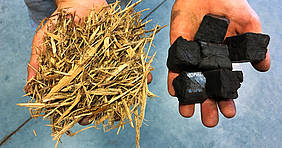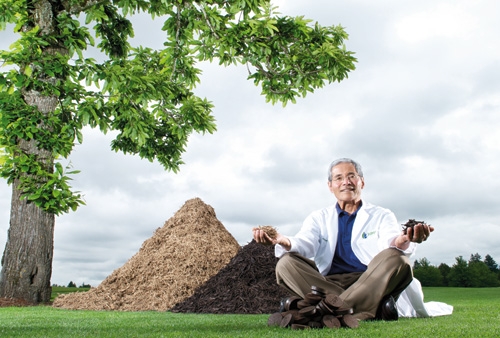The audacious plan from Hiroshi Morihara is becoming a reality. His startup, HM3 Energy, recently opened a production plant in Troutdale.
HM3 Energy, an Oregon-based cleantech startup, has developed a proprietary process that has the potential to cut air pollution from two major sources — coal-fired power plants and waste wood burned by logging operations — while creating hundreds of new jobs in rural timber communities.
The technology provides forest managers with an alternative to onsite, open burning of logging slash (branches, brush, defective trees and low value species such as juniper) by transforming the waste wood into sturdy biomass briquettes that can be sold and shipped to power plants as a drop-in replacement for coal.
Burning the HM3 briquettes instead of coal eliminates toxic mercury and sulfur emissions associated with coal burning, and cuts nitrous oxide by 30 percent. The briquettes have a 30 percent higher energy value than raw wood pellets and are comparable energy-wise to western (sub-bituminous) coal.
The process has attracted the attention of a Japanese utility that is looking to site a commercial briquette production plant in Oregon based on the technology.
HM3 announced the news at the grand opening and tour of its newly completed demonstration plant in Troutdale, Ore., where it has successfully converted juniper forest slash into the cleaner-burning briquettes. HM3 has demonstrated the process to potential customers, but this was the first time the company has opened the plant to energy policy makers, forestry managers and others in the timber industry.
The $4 million demonstration plant was constructed using commercial grade equipment, and can be easily scaled up for construction of commercial sized plants in rural Oregon or anywhere a sustainable biomass supply is available.
Oregon Sen. Ron Wyden, who attended the event, has been supportive of HM3 Energy’s work over the years.
The process developed by HM3 roasts the slash in an oxygen-free, high-temperature process called “torrefaction.” After torrefaction, the roasted biomass is formed into large, water-resistant briquettes that — like coal — can be transported and stored without cover and require no modifications to existing coal-fired power plants.
“Utilities worldwide, as well as Oregon’s own Portland General Electric, are looking for clean burning fuel to replace coal in their electric generation plants,” said Hiroshi Morihara, president and CEO of HM3 Energy. “We already have a ready-made first customer. New Energy Development Co., a utility in Japan that operates biomass electric generation plants, is actively seeking an appropriate site in Oregon to build a commercial plant that utilizes our waste-to-energy technology.”
Initial seed money for the demonstration plant came from an international consortium of five companies led by New Energy Development Co., which has invested almost $2 million in HM3 Energy. Prior to this, HM3’s funding was through smaller stock sales and grants.
“Our technology was so novel, it scared away most private investment,” Morihara said. “We couldn’t have done it without the help of all our supporters, including investors and funders such as Oregon BEST, the USDA-SBIR program, the U.S. Endowment for Forestry and Communities, and Business Oregon.”
In 2012, Oregon BEST funded a collaborative research project between HM3 Energy and Oregon State University that performed testing and generated data about drying times and emissions from different types of woody biomass.
“We are excited to have supported HM3 during their early research and development and thrilled to now see the potential this clean technology has to bring significant environmental and economic benefits to Oregon and beyond,” said Johanna Brickman, director of innovative collaboration at Oregon BEST. HM3 Energy plans to license its proprietary technology to entities wanting to build commercial plants. The company has two patents, another pending, and continues to file more as it operates the demonstration facility.
The Troutdale facility will continue to demonstrate the company’s technology on a variety of feedstocks, including woody biomass from different tree species, urban wood waste from tree prunings, and agricultural residues from crops such as corn, sugar cane and coconuts.
“We are open for business and ready to demonstrate our technology on whatever biomass a customer wants to bring us,” Morihara said.



